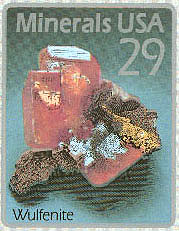
|
History of Geology |

Born: 7 Nov. 1867, Warsaw, Poland.
Died: 4 July 1934, Sancellemoz, France.
| Abstract | Introduction |
| Polish history | Major accomplishments |
| Historical assessment | References |

|
History of Geology |

Born: 7 Nov. 1867, Warsaw, Poland.
Died: 4 July 1934, Sancellemoz, France.
| Abstract | Introduction |
| Polish history | Major accomplishments |
| Historical assessment | References |
As a youth, Maria regularly attended the nearby Church of the Visitation of the Virgin Mary. She was educated at a private girls boarding school, then at the public gymnasium (high school), and she graduated with a gold medal in 1883. From 1884 to 1889, she attended illegal university courses. She excelled in multiple languages as well as sociology, psychology and science. Her goal was to attend the Sorbonne in Paris, as women were not allowed to enroll in Polish universities at that time (Sobieszczak-Marciniak, undated).
In 1891 Maria went to Paris to study at the Faculte des Sciences at the Sorbonne (now known as Paris-Sorbonne University), where she lived with her sister, Bronisława, and husband. The Sorbonne is among the oldest universities in the world, founded in the thirteenth century, and justifiably famous. She obtained licenciate degrees in physics in 1893 and mathematics in 1894. There she met Pierre Curie (1859-1906), who was a French physicist, and they were married in 1895. They had two daughters, Irene and Eva. Pierre with his brother Jacques had discovered the phenomenon of piezoelectricity, and he was a colleague of Lord Kelvin who had visited his laboratory. From that point on Maria lived most of her life in Paris, although she often visited her Polish homeland.
During the next two centuries, however, this region was partitioned by neighbors until Poland ceased to exist as an independent nation (see 1800 map), and this state of affairs continued until the turn of the twentieth century (see 1900 map). Throughout the era of foreign domination, nonetheless, Poland retained a strong sense of identity through its culture and language. It was during this turbulent period that Maria Skłodowska received her early education. Poland and France have long enjoyed close cultural and diplomatic relationships and respect for each other; thus, it is no surprise that Maria moved to Paris for her advanced education.
Following World War I, Poland emerged briefly as a fully independent nation, but again it was partitioned at the beginning of World War II (see 1939 partition). The modern outline of Poland was determined following World War II and has remained stable until today (see 2000 map). The period of Soviet/Communist domination came to an end in 1989, and Poland has emerged as a fully modern country with a dynamic economy, vibrant culture, and active scientific inquiry equal to those of many western European countries.
Maria Skłodowska-Curie is the only woman to have won Nobel Prizes in two different subjects. She became the Director of the Curie Laboratory at the Radium Institute in Paris in 1914 and directed it until her death. During World War I, Maria and her daughter, Irene, took portable x-ray units into the battlefield to train technicians and examine wounded soldiers. She increasingly spent more time in such remedial work involving medical applications of radiation. Following the war, she continued research on polonium, actinium, and ionium at the institute.
During the period 1925-32, she established the Radium Institute in Warsaw. Her primary interest was in medical applications for treatment of cancer, but late in life began to suspect also radiation damage to her health as well as the health of radium workers. In 1929 President Hoover gave $50,000 donated by American friends of science for her to purchase radium for the institute in Warsaw (Nobel 1967). On July 4, 1934 she died in France of leukemia brought on by her prolonged exposure to radioactivity. Initially she was buried in a common grave with her husband in Sceaux. In 1995, the ashes of both were transferred to the Paris Panthéon. She is the only woman and the only person not born in France so honored (WTO 2016).
Maria Skłodowska-Curie was well connected with and highly regarded by the most famous physical scientists of the early twentieth century. She attended the Solvay Conferences, which dealt with major issues in physics and chemistry and attracted the pre-eminent scientists of the day. Of the 29 participants in 1927, for example, 17 had won or would win Nobel Prizes, but Maria was the only one to receive two. Other participants included such noteworthies as Albert Einstein, Niels Bohr, Erwin Schrödinger, Werner Heisenberg, Max Planck, and William Lawrence Bragg.
Introduction
Maria Skłodowska was born in the Nowe Miasto (new town) of Warsaw Poland in 1867. Nowe Miasto is located just north of the wall and gate into Stare Miasto (old town), the historical center of Warsaw. Maria lived the first year of her life at 16 Freta Street, then her family moved to another location in Warsaw (Kabzińska and Damska-Choina, undated). Both her parents were school teachers; her father taught physics and math at a grammar school for boys, and her mother ran a boarding school for girls at 16 Freta Street (Sobieszczak-Marciniak, undated). Maria was the youngest of four daughters and one son. After her mother died in 1878, the family was raised by her father.Brief Polish history
At one time, Poland was a great country that stretched from the Baltic Sea southward almost reaching the Black Sea. Already by the sixteenth century, Poland had produced one of the most famous astronomers of all time, namely Mikołaj Kopernik, better known as Nicholas Copernicus (1453-1543). At the beginning of the seventeenth century, the Commonwealth of the Crown of the Polish Kingdom and the Grand Duchy of Lithuania (Poland-Lithuania) was the largest and most powerful country in north-central Europe (see 1600 map).

Centrum Nauki Kopernik (Copernicus Science Centre) is a science museum and conference center that openned in 2010. Located in Warsaw, it is the most popular attraction in all of Poland. It includes the Heavens of Copernicus planetarium. Photo by JSA.
Major accomplishments
Maria Skłodowska-Curie and her husband began their marriage by investigating the newly discovered phenomenon of radioactivity in uranium and thorium. They worked in a laboratory that was converted from an old shed (Sobieszczak-Marciniak, undated). They discovered two new elements, polonium (Po, named for her homeland) and radium (Ra), in 1898. In 1903 she received her doctorate degree in physical sciences. In that same year, she shared the Nobel Prize for Physics with her husband and Henri Becquerel. She was the first woman to win a Nobel Prize; on the Nobel certificate her name was listed as Marie Curie (Sobieszczak-Marciniak, undated).
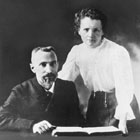
Pierre Curie and Maria Skłodowska-Curie circa 1903, the year they won the Nobel Prize in Physics with Henri Becquerel. Public domain from the Smithsonian Institution Archives; adapted from Wikimedia Commons.

Participants at the fifth Solvay Conference in 1927. This has been called the most intelligent picture ever taken. Maria Skłodowska-Curie is seated third from left on the front row, the only woman in the picture. Obtained from Rare historical photos.
Historical assessment
Without question, Maria Skłodowska-Curie was the greatest female scientist the world has seen. In addition to her two Nobel Prizes, one shared with her husband and Becquerel, her daughter and two sons-in-law also received Nobel Prizes. Irène Joliot-Curie (1897-1956) and her husband, Frédéric Joliot (1900-1958) shared the Nobel Prize for Chemistry in 1935 for their discovery of artificial radioactivity and isotopes. Her younger daughter, Eva, was the second wife of Henry Labouisse (1904-1987), who accepted the Nobel Prize for Peace on behalf of UNICEF in 1965. Thus, the Curie clan was undoubtedly the greatest Nobel family of all time with five awards in three categories.

| Polish 20,000 zloty banknote from 1989 featured Maria Skłodowska-Curie on the front side and the first Polish nuclear reactor, named Ewa, on the backside. From the author's collection. | 
|
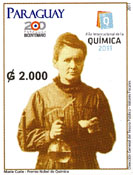 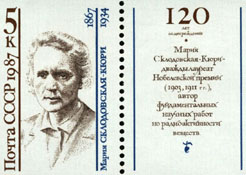 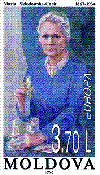 |
Return to history of geology syllabus or schedule.References

© J.S. Aber (2021).